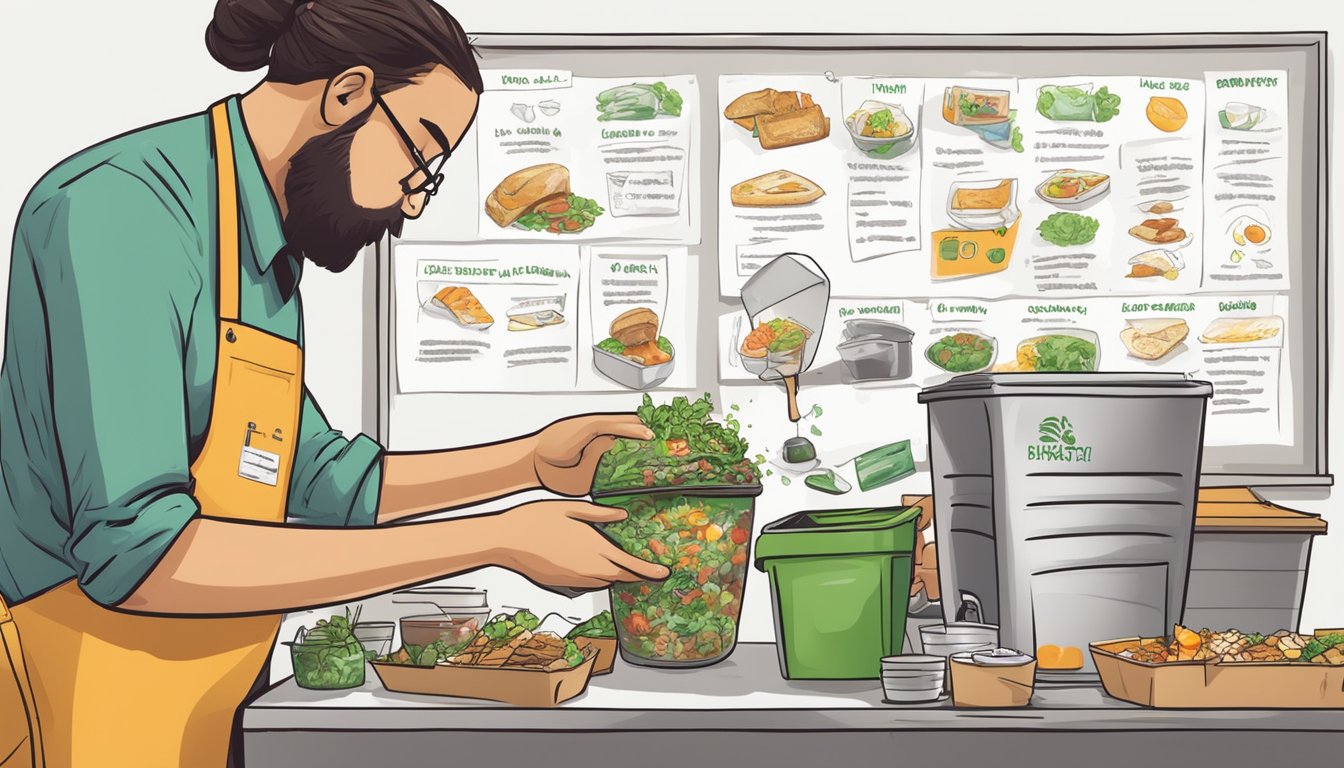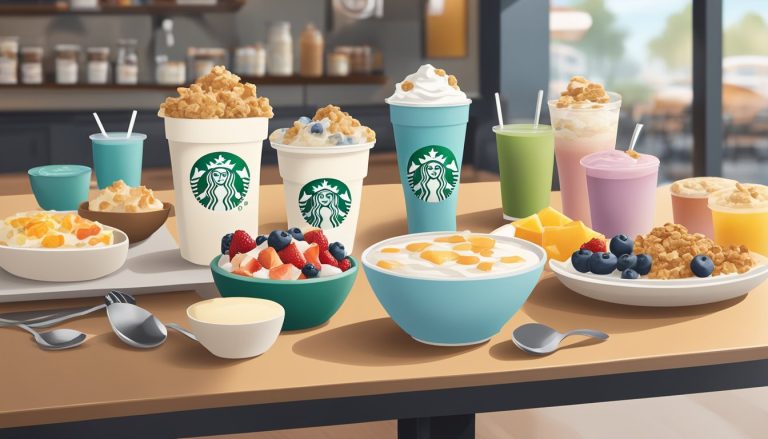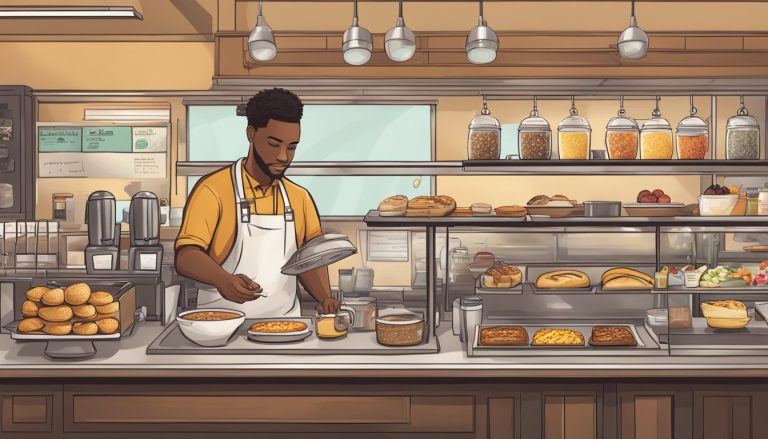Starbucks, the global coffee giant, is taking significant steps to address food waste in its breakfast offerings. As part of its broader sustainability initiatives, the company is focusing on reducing waste sent to landfills from its stores and manufacturing processes. By 2030, Starbucks aims to cut its waste by 50%, with breakfast food waste reduction playing a crucial role in this ambitious goal.
The company’s approach to breakfast food waste reduction aligns with its environmental promise to give more than it takes from the planet. Starbucks is exploring innovative solutions to minimize waste across its operations, including its popular morning menu items. This effort extends beyond the coffee counter, encompassing the entire supply chain and production processes.
Starbucks is also partnering with organizations like the Farm Powered Strategic Alliance to repurpose food waste into renewable energy. This collaboration not only helps reduce the company’s environmental footprint but also supports regenerative agriculture practices. By transforming waste into a valuable resource, Starbucks is setting a new standard for sustainability in the food service industry.
Company Background and Sustainability Goals
Starbucks has positioned itself as a leader in corporate sustainability efforts. The company has set ambitious environmental targets and integrated sustainability into its core business strategy and operations.
Starbucks’ Mission and Vision
Starbucks aims to inspire and nurture the human spirit – one person, one cup, and one neighborhood at a time. This mission extends to environmental stewardship. The company envisions becoming resource-positive, giving back more to the planet than it takes. Starbucks emphasizes ethical sourcing, community engagement, and reducing its environmental footprint across its global operations.
Environmental Goals and Commitments
Starbucks has pledged to cut its carbon emissions, water usage, and waste by 50% by 2030. The company is working to develop more eco-friendly stores, packaging, and products. Efforts include eliminating plastic straws, increasing recycled content in packaging, and expanding plant-based menu options. Starbucks also invests in renewable energy and regenerative agricultural practices in its supply chain.
Kevin Johnson’s Role in Sustainability
As CEO from 2017 to 2022, Kevin Johnson accelerated Starbucks’ sustainability initiatives. He spearheaded the company’s resource-positive commitment and set science-based targets for carbon, water, and waste reduction. Johnson emphasized innovation in sustainable store designs and circular economy principles. He also expanded Starbucks’ efforts around sustainable coffee sourcing and farmer support programs.
Starbucks’ Approach to Resource Management
Starbucks has implemented several strategies to manage resources more sustainably and reduce its environmental impact. These efforts focus on packaging, waste reduction, and partnerships to promote a circular economy.
Promoting Reusable Packaging
Starbucks encourages customers to bring their own reusable cups for beverages. The company offers a small discount for those who use personal cups or mugs.
In some markets, Starbucks has tested cup-sharing programs. These initiatives allow customers to borrow reusable cups and return them to participating stores.
The company has set ambitious goals to increase the use of reusable packaging. By 2025, Starbucks aims to provide a reusable cup option for every transaction in its stores.
Recycling and Compost Initiatives
Starbucks has invested in developing recyclable and compostable packaging solutions. The company works to ensure its cups, lids, and other packaging materials can be easily recycled or composted.
In-store recycling and composting programs have been implemented in many Starbucks locations. These efforts help divert waste from landfills.
Starbucks collaborates with local waste management providers to improve recycling infrastructure. This includes supporting the development of new technologies and processes for handling food service packaging.
Partnership with Ellen MacArthur Foundation
Starbucks has joined the Ellen MacArthur Foundation’s New Plastics Economy Global Commitment. This partnership demonstrates the company’s dedication to creating a circular economy for plastics.
Through this collaboration, Starbucks works to eliminate unnecessary plastic packaging and increase the use of recycled content in its products.
The company shares best practices and innovations with other signatories of the commitment. This collaboration helps drive industry-wide progress towards more sustainable packaging solutions.
Reducing Environmental Impact
Starbucks has implemented comprehensive strategies to minimize its ecological footprint. The company focuses on key areas including emissions reduction, responsible water management, and energy-efficient store designs.
Lowering Carbon Emissions
Starbucks aims to cut its carbon emissions by 50% by 2030. To achieve this, the company is transitioning to renewable energy sources for its stores and roasting facilities. They have invested in wind and solar farms to power operations with clean electricity. Starbucks is also updating its transportation and distribution networks to use more fuel-efficient vehicles and optimize delivery routes.
The company is working with coffee farmers to implement sustainable agriculture practices that sequester carbon in soil and trees. This includes providing farmers with climate-resistant coffee plant varieties and training on conservation techniques.
Water Use and Replenishment
Water conservation is a priority for Starbucks. The company has set a goal to replenish more water than it uses in coffee production and store operations. In coffee-growing regions, Starbucks supports projects to protect watersheds and improve water access for communities.
In stores, water-saving technologies like efficient dishwashers and low-flow faucets have been installed. Baristas are trained on water conservation practices. Starbucks also partners with local organizations on clean water initiatives in countries where it sources coffee.
Energy-Efficient Store Designs
Starbucks is redesigning its stores to be more eco-friendly and resource-positive. New and renovated locations incorporate energy-saving features like LED lighting, high-efficiency HVAC systems, and improved insulation. Some stores utilize smart building management systems to optimize energy use.
The company’s Greener Stores framework guides the development of sustainable retail spaces. This includes using recycled and locally-sourced building materials, installing solar panels where feasible, and implementing waste reduction strategies. Starbucks is also testing new store formats that are smaller and more energy-efficient.
Innovative Approaches to Food Waste

Starbucks has implemented several creative strategies to tackle food waste in its breakfast offerings. These initiatives focus on maximizing resource utilization and minimizing environmental impact across the supply chain.
Upcycling and Re-Purposing Food Waste
Starbucks has partnered with local bakeries to transform unsold pastries into new products. Day-old croissants become crispy croutons for salads, while muffins are crumbled into parfait toppings.
The company also donates edible leftover food to local food banks and shelters. This reduces waste while supporting community organizations.
Inedible food scraps are composted or used as animal feed on partner farms. Coffee grounds are offered to customers for gardening or mixed into beauty products sold in stores.
Drive-Thru Recycling Solutions
Starbucks has redesigned its drive-thru windows to include recycling and compost bins. Customers can easily sort their waste without leaving their vehicles.
Special packaging with clear recycling instructions helps guide proper disposal. The company uses QR codes on packaging to provide detailed recycling information.
Drive-thru orders now come in reusable containers when possible. Customers receive discounts for returning these containers on future visits.
Collaboration with Farmers
Starbucks works directly with coffee and food suppliers to reduce waste at the source. The company provides training on sustainable farming practices and post-harvest handling.
Imperfect produce that doesn’t meet aesthetic standards is purchased and used in smoothies and baked goods. This prevents edible food from being discarded.
The company has invested in cold storage facilities near farms. This extends the shelf life of perishable ingredients and reduces spoilage during transport.
Starbucks also supports research into drought-resistant crop varieties. This helps ensure a stable supply while reducing water waste in agriculture.
Sustainable Sourcing and Menu Options

Starbucks has implemented several initiatives to enhance sustainability in its sourcing practices and menu offerings. These efforts focus on plant-based options, supporting regenerative agriculture, and ethical coffee sourcing.
Plant-Based Menu Development
Starbucks has expanded its plant-based menu options to cater to environmentally conscious consumers. The company has introduced various milk alternatives, including soy, almond, coconut, and oat milk. These options reduce the carbon footprint associated with dairy production.
Plant-based food items have also been added to the menu. Vegan breakfast sandwiches and wraps are now available in many locations. These items use ingredients like plant-based eggs and meat substitutes.
Starbucks continues to innovate in this area, developing new plant-based recipes that appeal to a wide range of customers. The company aims to reduce its environmental impact while meeting changing consumer preferences.
Supporting Regenerative Agriculture
Starbucks has committed to supporting regenerative agricultural practices in its supply chain. This approach focuses on restoring soil health and biodiversity while reducing carbon emissions.
The company partners with farmers to implement sustainable farming techniques. These include crop rotation, cover cropping, and reduced tillage. Such practices help improve soil quality and increase carbon sequestration.
Starbucks has also joined the Farm Powered Strategic Alliance. This initiative repurposes food waste from the supply chain into renewable energy through anaerobic digestion. The process produces low-carbon fertilizer, which farmers use to support regenerative practices.
Ethical Coffee Sourcing
Starbucks has long been committed to ethically sourcing its coffee. The company’s C.A.F.E. (Coffee and Farmer Equity) Practices program sets standards for responsible purchasing.
This program ensures fair wages for farmers and promotes environmentally friendly cultivation methods. Starbucks works directly with coffee growers to improve their practices and increase sustainability.
The company has invested in eco-friendly technologies to reduce water usage in coffee processing. Starbucks has installed 1,300 eco wet mills globally, which can save up to 80% of water compared to traditional methods.
Starbucks aims to make its coffee 100% ethically sourced. This commitment extends to all aspects of the supply chain, from farm to cup.
Community Engagement and Customer Incentives
Starbucks implements various strategies to involve customers and communities in its breakfast food waste reduction efforts. These initiatives aim to create lasting impact through incentives, education, and community partnerships.
Reward Programs for Reuse
Starbucks offers a reusable cup program to encourage customers to reduce disposable cup waste. Customers who bring their own clean, reusable cups receive a discount on their beverage purchase. The company has set a goal to increase reusable cup usage significantly by 2025.
To further promote this initiative, Starbucks has introduced a digital rewards system. Customers earn extra loyalty points when they choose reusable options, which can be redeemed for free food and drinks.
The company also runs periodic promotions where customers can receive a free reusable cup with their purchase, making it easier for them to participate in waste reduction efforts.
Educating Consumers on Sustainability
Starbucks uses in-store signage and digital communications to inform customers about its sustainability goals. These materials highlight the environmental impact of food waste and suggest ways customers can contribute to reduction efforts.
The company’s mobile app features a sustainability section. It provides tips on reducing food waste at home and explains how Starbucks manages its own waste streams.
Starbucks partners with environmental organizations to create educational content. This collaboration results in engaging videos and infographics shared on social media platforms, reaching a wider audience.
Building An Equitable Relationship with Communities
Starbucks establishes community stores in underserved areas. These locations partner with local non-profits to provide job training and community programs, including food waste reduction initiatives.
The company’s FoodShare program donates unsold food to local food banks. This effort not only reduces waste but also supports food security in communities.
Starbucks engages in community clean-up events. These activities raise awareness about waste reduction and foster a sense of shared responsibility among residents.
The company also sponsors sustainability-focused youth programs. These initiatives empower young people to become environmental leaders in their communities.
Long-Term Impact and Future Goals

Starbucks is taking decisive action to reduce its environmental footprint and create positive change in the coffee industry. The company has set ambitious targets and implemented initiatives focused on sustainability, conservation, and greening its supply chain.
Progress Toward Science-Based Targets
Starbucks has committed to science-based targets to cut its carbon emissions, water use, and waste. By 2030, the company aims to reduce carbon emissions from direct operations and electricity use by 50%.
Water conservation efforts target a 50% reduction in water withdrawal for direct operations and coffee production. Starbucks is also working to halve food and packaging waste going to landfills.
In 2022, 3,500 Starbucks stores reduced their carbon emissions, water usage, and landfill waste. This represents about 10% of the company’s global store footprint, demonstrating tangible progress.
Forest Conservation and Reforestation Efforts
Starbucks has pledged to conserve or restore 100 million trees by 2025. This commitment supports coffee-growing communities and helps mitigate climate change impacts.
The company partners with Conservation International to protect forests in key coffee-growing regions. Projects include reforestation in Indonesia and agroforestry initiatives in Mexico and Peru.
Starbucks also invests in its own coffee farm, Hacienda Alsacia in Costa Rica. Here, the company tests innovative farming methods to increase yields while reducing environmental impact.
Striving for a Greener Supply Chain
Starbucks is working to make its entire supply chain more sustainable. The company has achieved 98% ethically sourced coffee, verified through its C.A.F.E. Practices program.
Efforts to reduce packaging waste include introducing new cold cups made with up to 20% less plastic. Starbucks is also testing reusable cup programs in select markets.
The company is expanding its network of LEED-certified stores, with over 1,000 locations already meeting these green building standards. Additionally, Starbucks is installing EV chargers at stores along key routes to support sustainable transportation.




